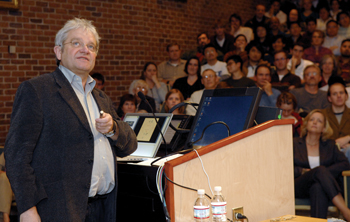
Sir Paul Nurse, Ph.D., left, presented Monday's Discovery Lecture to a packed house in Light Hall. (photo by Dana Johnson)
Nobel Laureate details perils, pitfalls of discovery’s cycle

Even Nobel-prize winning research can be replete with trial and error, unexpected and unbelievable findings, and a little bit of serendipity.
At last week's Discovery Lecture, Sir Paul Nurse, Ph.D., Nobel Laureate and president of The Rockefeller University, discussed his work — and all its perils and pitfalls — towards deciphering the cell cycle.
The complexity of the cell cycle, the orderly series of events by which one cell becomes two, can be overwhelming, Nurse said.
“If you go to read a review of the cell cycle these days, you will probably get rather depressed,” he said, “because somewhere in the review the author will try to put it all together with some sort of diagram that resembles the New York subway map.”
Nurse started with a much simpler diagram of the cell cycle, which contains four major phases.
He has devoted his career to uncovering the molecules that control progression through these phases using the fission yeast Schizosaccharomyces pombe.
Showing what he described as a “mildly pornographic” slide of the elongated and ovoid cells, he quipped, “This is the yeast that I've committed my life to.
“My family thinks I'm a very sad individual to have done that.”
The unusual yeast is not so good for making bread and turns out a “rather disgusting East African beer called 'pombe,'” Nurse said.
“But it isn't a bad organism for studying the cell cycle.”
In a lecture frequently punctuated by bursts of laughter, Nurse detailed his identification of a yeast gene, called cdc2, that controls the progression of the cell cycle and his lab's eventual identification of the homologous human gene, CDK1.
The startling similarity between the yeast and human genes that his group found — despite their millions of years of evolutionary divergence — “shows that you can use yeast as a good model to study human gene function,” he said.
For a complete schedule of the Discovery Lecture Series and archived video of previous lectures, go to www.mc.vanderbilt.edu/discoveryseries.













